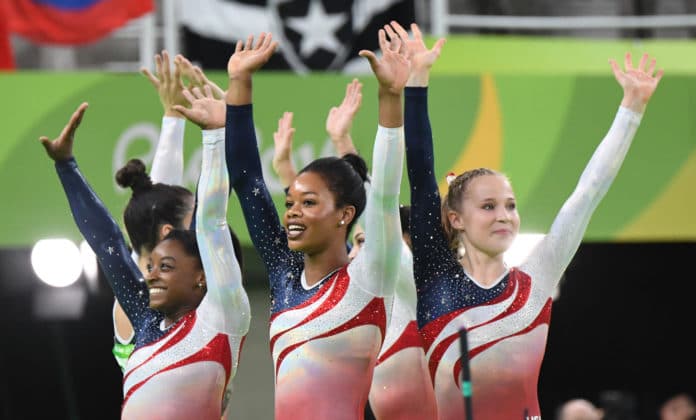RIO DE JANEIRO – Well before Tuesday’s team final at Rio Olympic Arena, the five members of the U.S. Olympic women’s gymnastics squad huddled via cellphone for an athletes-only meeting.
The sole agenda item: Come up with a nickname – something that would define them forever if they won team gold in Rio to take their place alongside the Magnificent Seven of the 1996 Atlanta Olympics and the Fierce Five of the 2012 London Games.
They swore to keep it a secret, like the best sisters do, until the time was right.
With Simone Biles’s dazzling exercise providing the final flourish to what had been a near-perfect competition, that time came Tuesday afternoon – shortly after the scoreboard confirmed they’d won the gold by a whopping margin over fierce rivals Russia and China, and just before they stepped up to the podium to receive their medals.
During the delirious hug-fest in between, U.S. national team coordinator Martha Karolyi rushed to the arena floor to tell her young charges how much she loved them.
They told her, in return, the nickname they’d chosen: “The Final Five,” a tribute to the 73-year-old Karolyi, who’ll retire after the Rio Games, having pushed, prodded and nurtured this one last cohort of champions to Olympic gold.
“We told Martha the name, and she started crying,” said Aly Raisman, 22, the two-time Olympian who’s also the team’s captain. “It’s very hard to make Martha cry.”
Added Biles, 19, the joyful Texan who soars above all other gymnasts: “She actually started crying! It was so cute! She was so proud of us. And she said, ‘This is why we do so many repetitions in practice.’ “
The U.S. women staked a lead at the outset of the eight-nation competition and padded it with their complex skills and steadiness at every rotation. And how fitting that they ended the competition on floor exercise, the stage Biles loves best. The same is true for Raisman and 16-year-old Laurie Hernandez, competing in her first Olympics, who preceded Biles on floor exercise.
With back-to-back-to-back routines of daring tumbling and delightful dance, the U.S. women claimed their third team gold in the past six Summer Olympics, finishing with 184.897 points – 8.209 points ahead of Russia’s 176.688. It was the largest margin of victory in an Olympic women’s team final since the 1960 Games in Rome, where the Soviet Union defeated Czechoslovakia by 8.997 points.
China (176.003) took bronze.
The team final is a test of a nation’s breadth and depth of gymnastics talent. From a five-woman squad, each nation picks three gymnasts to compete on the four apparatus. All three scores count, so every fall, stumble or bumble is costly.
Tuesday in Rio, each trio that Karolyi tasked with an event posted the top collective score on the apparatus. And Biles led the way on three events: vault, beam and floor.
World co-champion on uneven bars, Madison Kocian delivered the top score on her specialty, with 2012 Olympic all-around champion Gabby Douglas a close second.
“I can’t believe what we did tonight,” said Biles, who could leave Rio with five gold medals, yet to compete for in all-around, vault, beam and floor finals. “I mean, I can believe it because we’ve been putting in the work, and all of our hard work has finally paid off. Still, I don’t believe it.”
Biles said she planned to sleep with her gold medal beside her bed “so that it doesn’t get away.”
The Americans started on vault. With Hernandez, their youngest member, leading off with a Yurchenko double full, all U.S. three vaulters earned execution marks of 9.300 or higher. Raisman and Biles wowed with well-rendered Amanars.
In the lead, they moved to uneven bars. At 4 feet 8, Biles isn’t ideally suited to the apparatus but was solid. Next up was Douglas, who’s five inches taller. She delivered beautifully, with powerful release moves and lovely extension. Kocian then displayed the virtuosity that clinched her spot on the team.
Midway through the competition, the U.S. women held a lead of more than four points over China, with Russia close behind.
From there, they moved to the balance beam: a four-inch-wide test of nerves that can trip up even the best prepared gymnast. All three Americans wobbled and swayed at one point, but all three quickly regained their poise to stay on and finish strong.
Hernandez was a special delight, despite a few balance-checks – so stylish in her movement, so committed to each turn and tumbling pass.
Their lead now nearly five points, the U.S. women headed to the springy tumbling mat for floor exercise. Hernandez went first. The crowd loved her music; they loved her, as she pranced and danced with the frivolity of a child showing off in the back yard, sprinkled dynamic tumbling throughout.
Raisman, the 2012 Olympic gold medalist on floor exercise, staged a more mature routine with a veteran’s command, her strongest tumbling pass coming last.
Biles brought the arena to life with the samba flavor of a routine she clearly loves. Her tumbling drew audible gasps and squeals as her compact body flipped through the air, weightless as a feather. Each landing was sure-footed; each swivel and pose spiced by a brilliant smile. Her final tumbling pass concludes with a split-second’s plop on the mat, a bounce back to her feet and big smile.
The applause was even bigger. And the crowd was still cheering as Biles bounded off the mat and disappeared into the outstretched arms of her U.S. teammates, gold medalists all.






